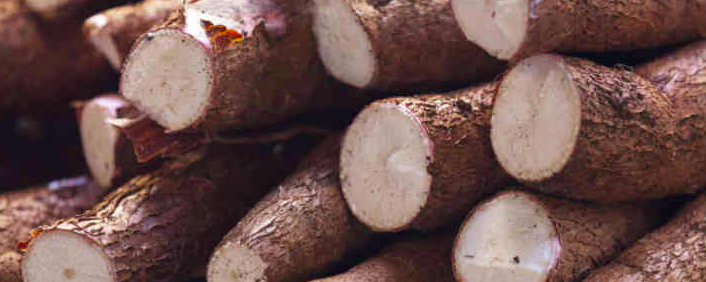
The health benefits of cassava
Rich in carbohydrates
The high carbohydrate intake of cassava makes it a starchy food easy to integrate into meals, it can for example replace the potato or semolina if it is consumed in the form of cassava flour.
Gluten free
Cassava and its derivatives (including tapioca ) do not contain gluten, so it is a product to be incorporated into the diet of people suffering from celiac disease or gluten intolerance.
Digestible
The high starch content of cassava makes it easily digestible, it will also help regulate problems with diarrhea or colon irritation.
Satisfying
It is also the cassava starch that will take up volume in the stomach and allow you to feel full at the end of a meal.
Nutritional values of cassava
Per 100 g of cassava
| Water | 59.7g |
| Carbohydrates | 36.3g |
| Fat | 0.29 g |
| Protein | 1.31 g |
| Magnesium | 21 mg |
| Potassium | 217 mg |
| Vitamin C | 20.6 mg |
| Vitamin B9 | 27 µg |
| Energy | 157 kcal |
| Energy | 664 kJ |
The main nutrients in cassava
Carbohydrates
The carbohydrates in cassava are mainly composed of starch, which makes it a starchy interesting to integrate into menus.
Magnesium
Cassava will – thanks to its magnesium content – strengthen the body’s immune defenses but also contribute to the proper functioning of muscles and the nervous system.
Potassium
Potassium will play an interesting role in the transmission of nerve impulses and help in a good contraction of the muscles of the body, as well as of the heart.
Vitamin C
The antioxidant activity will be provided by vitamin C contained in cassava, this vitamin will also allow good absorption of non-heme iron (provided by green vegetables and legumes in particular).
Using cassava in the kitchen: some recipe ideas
The taste of cassava
The flavor of the cassava is relatively neutral, it is similar to the potato and there is also an aftertaste of chestnut.
How to choose cassava?
It is the root of the cassava which is consumed because it is very rich in starch, we eat – more rarely – its leaves. A beautiful cassava root measures between 30 and 50cm long and 5 to 10cm in diameter. An average tuber weighs between 1 and 3 kg.
The root is brown in color and the flesh is white, it turns yellow when cooked.
There are two varieties of cassava:
- Bitter cassava: It is the most complicated to prepare, it can be toxic if it is undercooked.
- Sweet cassava: This type of cassava is easier to cook, it contains only minute quantities of toxic substances which disappear when cooked.
How to store cassava properly?
Rich in water, cassava is a fragile food, so it will keep for a few days in the refrigerator.
How to cook cassava ?
If you choose bitter cassava, be careful to prepare it because it contains cyanide (a toxic substance that can be fatal in high doses). The flesh of bitter cassava should be grated, washed, dried and cooked.
On the other hand, sweet cassava is prepared like a potato (in water or fried) and easily accompanies fish, meat and poultry.
Cassava can also be used as flour (looking like wheat semolina) or starch (like tapioca). Cassava is found in some typical African recipes such as cassava couscous, foufou, cassave or chikwangue but also in the composition of certain craft beers.
A short history of cassava
Cultivated in Central America and South America, cassava is also present in Africa. It is also a main food in local gastronomy because it is inexpensive and rich in carbohydrates, so very nutritious.